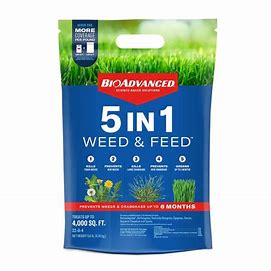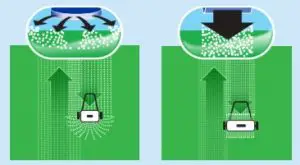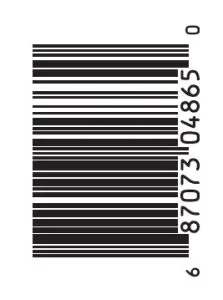
BIOADVANCED 5- In- 1 Weed andamp; Feed User Guide
DIRECTIONS FOR USE
FOR BEST RESULTS
- Apply to dew-wetted lawn.
- Apply when broadleaf weeds are young and actively growing.
- If the lawn needs mowing, do it 1 to 2 days before (for best results) or 2 days after applying this product.
- Clippings from the first three mowings should be left on the treated area.
Do not use the clippings from the treated areas as mulch or compost around flowers, ornamentals, trees, or in vegetable gardens. - If lawn is dry, water 1 to 2 days before using this product.
- Do not water for at least 24 hours after application or apply if rain is expected within 24 hours.
WEEDS CONTROLLED
GRASSY WEEDS: Pre-emergent control of crabgrass, foxtails, and other grassy weeds*. Post-emergent control of crabgrass.
BROADLEAF WEEDS: Pre-emergent control of broadleaf weeds*. Post-emergent control of over 200 broadleaf weeds*.
WHERE TO USE
Use only on established lawns of the following turf types: Bermudagrass**,
Buffalograss, Kentucky Bluegrass, Ryegrass, Fescue, Seashore Paspalum and Zoysia. DO NOT USE ON: Bahiagrass, Carpetgrass, annual bluegrass (Poa annua),
bentgrass, Centipedegrass, St. Augustinegrass (including Floratam) or Dichondra.
**Application to Bermudagrass may cause temporary yellowing or discoloration but full recovery can be expected.
HOW IT WORKS
This product contains four proven weed killers to control lawn broadleaf weeds* & crabgrass, roots and all. Also, it prevents crabgrass and broadleaf weeds for six months by forming a barrier at the top layer of the soil. And it won’t harm your lawn when used as directed. Weeds* begin to die in hours and are completely dead within 14-28 days. Plus, combined with fertilizer, feeds your
lawn for quick greening and long-lasting feeding. Treated crabgrass starts to purple in 3 days – that’s the sign that it’s working.
HOW TO USE
- Use rotary or drop type spreader to apply granules evenly over the lawn. To be sure you cover lawn areas uniformly, first treat the border of the lawn then fill in the center. Make parallel passes, walking at a steady pace to ensure even distribution of the granules.
- If using a broadcast or rotary spreader, make sure each strip overlaps the previous strip to ensure complete coverage. (See Fig. A)
- If using a drop spreader, make sure the wheels overlap the wheel marks in the grass from the previous strip to ensure complete coverage. (See Fig B.)
- Sweep, brush, or blow any accidentally applied material off driveways, sidewalks etc. back on to the lawn.
- After application, treated weeds may turn a slight purple color which is an indication that the herbicide is working.
SPREADER SETTINGS
If your spreader is not listed, please call our Consumer Service Hotline toll-free (877) 229-3724 for help.
Settings are approximate. The condition of your spreader, the speed at which you walk and uneven terrain may affect the rate of application. Calibrate your spreader according to manufacturer’s directions.
- Tip: 1,000 sq. ft. = 20 ft. x 50 ft.
- Do not use a spreader that applies granules in narrow, concentrated or uneven bands. Be sure the spreader works properly and spreads granules evenly.

Fig. A – Make sure each strip overlaps the previous strip to ensure complete coverage.
Fig. B – Make sure the wheels overlap the wheel marks in the grass from the previous strip to ensure complete coverage..
WHEN TO APPLY
This product may be applied as a single application or split applications in the spring and early summer or fall no closer than 30 days after the initial application.
- Apply in spring after the lawn is actively growing and has been mowed 2 times.
- Apply in fall no closer than [2-6 weeks] before the first historical frost date for your area.
– For grassy weeds such as crabgrass apply in spring and/or early summer.
– For best results, apply two weeks before anticipated weed seed germination or when weeds are small and actively growing (when crabgrass is emerging and is visible in thin turf areas).
– For broadleaf weed control, apply in spring and fall. - Apply when the air is calm to avoid drift onto desirable plants.
– Apply when temperatures are between 50–90ºF, and not above 85ºF on Bermudagrass.
– Lawns may be seeded 12 weeks after applying this product.
BEFORE USE RESTRICTIONS
- Do not apply this product in a way that will contact any person or pet, either directly or through drift. Keep people and pets out of the area during application.
- Do not allow people or pets to enter the treated area until dusts have settled.
- Use this product only on established lawns listed on this label – new lawns may be treated after the fourth mowing. Do not make sequential applications sooner than 30 days.
- Apply only to actively growing turf.
- Do not apply while turfgrass is just turning green in early spring.
- Do not apply this product if the lawn appears unhealthy e.g., due to lack of water, diseases, heat stress, chemical injuries, etc.
- Do not allow granules to come into contact with flowers, ornamental shrubs or trees, or other desirable broadleaf plants, as serious plant injury may occur.
- Do not make more than two applications per site in any 12-month period.
- Do not apply more than 2.4 lb. of this product per 1,000 sq. ft. per application.
- Do not release spray at a height greater than 30 inches above the ground.
RESEEDING, OVERSEEDING, OR SPRIGGING
- Reseeding, overseeding, or sprigging of treated areas with this product should be delayed until 12 weeks from the time of application.
- Reseeding, overseeding or sprigging before 12 weeks after application may prevent establishment of desirable turfgrasses.
- When reseeding or overseeding, proper cultural practices such as soil cultivation, irrigation and fertilization should be followed.
- If overseeding with perennial ryegrass in the fall, overseed 8 weeks or later after a single application.

Do not contaminate water, food, or feed by storage and disposal.
PESTICIDE STORAGE: Store in original container in a cool, dry place, out of the reach of children, preferably a locked storage cabinet. Protect from freezing.
 PESTICIDE DISPOSAL AND CONTAINER HANDLING:
PESTICIDE DISPOSAL AND CONTAINER HANDLING:
If empty: Non-refillable container. Do not reuse or refill this container. Place in trash or offer for recycling if available.
If partly filled: Call your local solid waste agency for disposal instructions. Never place unused product down any indoor or outdoor drain.

IF IN EYES: Hold eye open and rinse slowly and gently with water for 15 to 20 minutes. Remove contact lenses, if present, after the first 5 minutes, then continue rinsing eye. Call a poison control center or doctor for treatment advice. NOTE: Have the product container or label with you when calling a poison control center or doctor or going for treatment. You may contact 877-229-3763
for emergency medical treatment information.

This pesticide is toxic to fish and aquatic invertebrates. Do not apply directly to water, to areas where surface water is present, or to intertidal areas below the mean high water mark. Drift and runoff may be hazardous to aquatic organisms in water adjacent to treated areas. Do not contaminate water when disposing of equipment wash waters or rinsate. 2,4-D and dicamba have properties and characteristics associated with chemicals detected in groundwater. The use of this chemical in areas where soils are permeable, particularly where the water table is shallow, may result in groundwater contamination. Application around a cistern or well may result in contamination of drinking water or groundwater.
Dithiopyr is toxic to fish and highly toxic to other aquatic organisms including oysters and shrimp. Drift and runoff from treated turf may adversely affect aquatic organisms in adjacent aquatic sites.
To protect the environment, do not allow pesticide to enter or run off into storm drains, drainage ditches, gutters or surface waters. Applying this product in calm weather when rain is not predicted for the next 24 hours will help to ensure that wind or rain does not blow or wash pesticide off the treatment area. Sweeping any product that lands on a driveway, sidewalk, or street, back onto the treated area of the lawn or garden will help to prevent run off to water bodies or drainage systems. Do not apply when weather conditions favor drift from treated areas.
GUARANTEED ANALYSIS

Total Nitrogen (N) . . . . . . . . . . 22.0%
16.5% Urea Nitrogen
2.26% Water Insoluble Nitrogen
3.24% Other Water Soluble Nitrogen†††
Soluble Potash (K2O) . . . . . . . . . 4.0%
Sulfur (S) . . . . . . . . . . . . . . . . 1.36%
1.36% Combined Sulfur (S) F2414
Derived From: Urea, Methylene Ureas & Potassium Sulfate
†††3.24% slowly available Nitrogen from Methylene Ureas
This product does not contain live microbial inoculum. Fertilizer components are all synthetically derived.
Information regarding the contents and levels of metals in this product is available on the Internet at
http://www.aapfco.org/metals.html
Check with your county or city government to determine if there are local regulations for fertilizer use..
NOTICE
The “Directions for Use” of this product must be followed carefully. The buyer assumes, to the extent consistent with applicable law, responsibility for lack of performance or safety if not used according to the directions. Ineffectiveness or other unintended consequences may result because of such factors as weather conditions, presence of other materials, or the manner of use or application, all of which are beyond the control of SBM Life Science Corp. All such risks shall be assumed by the user or buyer.
ACTIVE INGREDIENTS
2,4-D (2,4-dichlorophenoxyacetic acid) . . . . . . . . . . . . . . . . . . . . . . . . . 0.818%
Quinclorac (3,7-dichloro-8-quinolinecarboxylic acid) . . . . . . . . . . . . . 0.419%
Dicamba (3,6-dichloro-o-anisic acid) . . . . . . . . . . . . . . . . . . . . . . . . . . . 0.073%
Dithiopyr (S,S dimethyl 2-(difluoromethyl)-4-(2-methylpropyl)-6-
(trifluoromethyl)pyridine-3,5-dicarbothioate) . . . . . . . . . . . . . . . . . 0.240%
OTHER INGREDIENTS . . . . . . . . . . . . . . . . . . . . . . . . . . . . . . . . . . . .98.450%
TOTAL . . . . . . . . . . . . . . . . . . . . . . . . . . . . . . . . . . . . . . . . . . . . . . . . . . . 100.000%
THIS PRODUCT CONTAINS:
0.00833 lb. 2,4-dichlorophenoxyacetic acid equivalent per pound of product 0.00428 lb. 3,7-dichloro-8-quinolinecarboxylic acid per pound of product 0.00074 lb. 3,6-dichloro-o-anisic acid equivalent per pound of product 0.00264 lb. Dithiopyr per pound of product Active Ingredients: 0.428% Quinclorac (CAS# 84087-01-4), 0.074% Dicamba (CAS #1918-00-9), 0.833% 2,4-D (2,4-dichlorophenoxyacetic acid) (CAS #94-75-7), and 0.264% Dithiopyr (CAS# 97886-45-8)
EPA Reg. No. 92564-75
EPA Est. No. indicated by 3rd and 4th digits of the batch number on this package. (57) = 071106-GA-003 (89) = 9198-AL-1 (36) = 9198-OH-1.
QUESTIONS OR COMMENTS?
Call toll-free (877) 229- 3724 or visit
us online at www.bioadvanced.com
